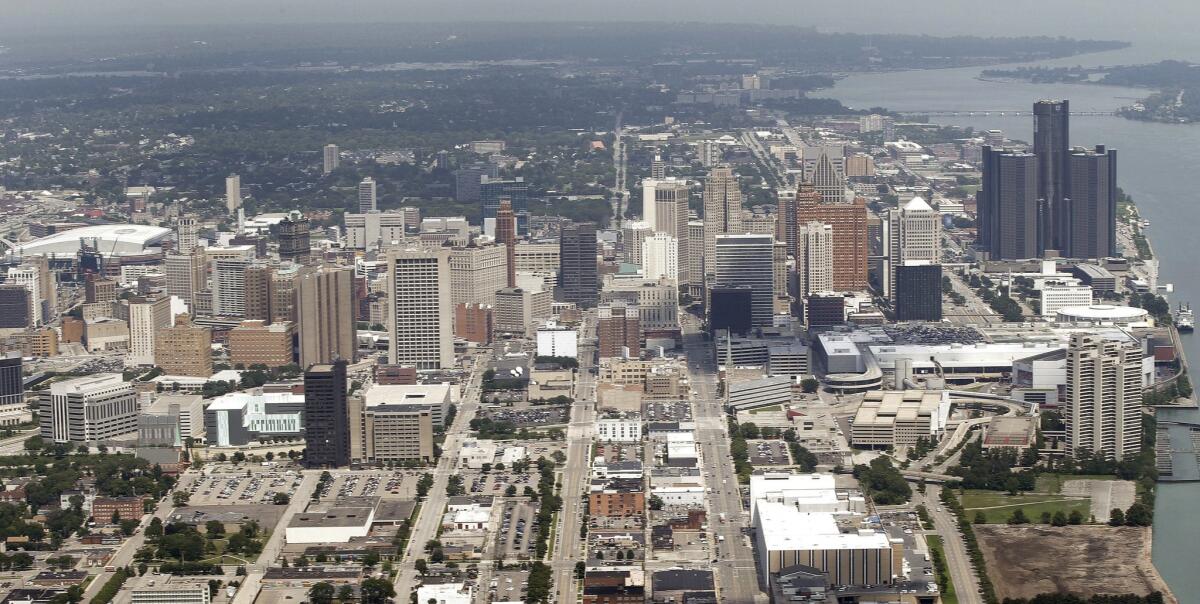With court’s approval, Detroit emerges from bankruptcy

Detroit emerged Friday from the nation’s largest municipal bankruptcy with a life line as it seeks to recover from an ocean of debt and mismanagement that threatened to drown the onetime symbol of U.S. industrial might.
The court approval of the city’s bankruptcy exit plan ends a painful chapter in Detroit history and opens new challenges as it grapples with urban blight, population flight and the decay of businesses.
The decision also reaches beyond Detroit’s borders, affecting bond markets, touching on how much pension protection retired city workers can expect if their city goes bankrupt and offering a blueprint for how future municipal bankruptcies can be handled, experts said.
Detroit Bankruptcy Judge Steven Rhodes announced Friday that he had accepted the agreement negotiated by city and state officials as well as lawyers representing 100,000 creditors owed a staggering $18.5 billion. With dignitaries including Mayor Mike Duggan looking on, the judge issued his decision from the bench, exhorting the conflicting parties to work together.
“What happened in Detroit must never happen again,” he said.
In explaining his decision, Rhodes noted: “The court also concludes that the settlements incorporated in the plan of adjustment are reasonable, fair and equitable. Accordingly, the court approves those settlements.”
Because it was a negotiated process, the key details have long been public. Detroit will cut the pensions of general retirees by 4.5% and will limit cost-of-living increases for police and firefighters. About $7 billion of debt will be erased, and debtors will be paid less than the full value of what they lent. An additional $1.7 billion will be spent by the city to demolish abandoned buildings, improve public safety and upgrade basic services.
What made the agreement possible, the judge said, was the ability of the various parties to sign on as partners in rebuilding the city. A key element of that cooperation was the so-called grand bargain involving the Detroit Institute of Art. Officials had threatened to sell off its assets to pay creditors, but the final agreement moves the museum into a free-standing charitable trust.
That agreement led to the creation of an $816-million fund donated by the state, foundations and philanthropists. The money is earmarked to patch holes in Detroit’s pension funds and prevent even deeper cuts to retirees.
Michigan Gov. Rick Snyder appointed Kevyn Orr as emergency manager in March 2013, giving Orr extraordinary powers to overturn municipal contracts, force the sale of assets and move on issues without having to seek the consent of elected officials. That action was widely credited with allowing the bankruptcy case to be quickly resolved, in about 16 months.
In California, it took more than two years for Stockton to get out of bankruptcy. San Bernardino is still operating under Chapter 9 protection more than two years after its filing.
“We had superb case management by the judge,” said Laura Beth Bartell, a bankruptcy professor at Wayne State University Law School in Detroit. “It shows what smart, competent people can do. When everyone realized the situation, there wasn’t a lot to argue about, once they resolved” the Detroit Institute of Art issue.
The biggest impact, perhaps, is the change in how public pensions are viewed. Earned by employees and funded by tax dollars and investment returns, such pensions were considered untouchable until the recent wave of government bankruptcies. Detroit wasn’t the first city to cut pensions, but it is the largest.
“Detroit’s plan resulted from a mediation process, implying little legal precedent-setting,” said Olivia S. Mitchell, professor of Business Economics and Public Policy at the Wharton School of the University of Pennsylvania and executive director of the Pension Research Council. “However, the conspicuousness of the city’s bankruptcy, the size of its debt, and the long-term erosion of its tax base, combined with the retiree cuts, should give pause to those expecting retirement benefits from the public sector.”
The pensions of non-uniformed workers will be cut 4.5%, and they lost their cost-of-living increase. Police and fire personnel had their cost-of-living increases cut from 2.5% to 1%. Both groups lost 90% of their healthcare benefits.
The severity of the cuts and the loss of the once-special position of pensions will probably force changes in how unions bargain with municipalities, said Robert Novy-Marx, a professor of finance with the Simon Business School at the University of Rochester.
“I think there’s going to be increasing incentive from the unions to negotiate better funding for pensions” as a way of protecting payments, he said. Bankruptcy is about apportioning pain among the various parties, he added.
“Every solution is about apportioning the pain,” Novy-Marx said. The situation is “a pile of toxic waste and someone has to eat it, and it is a zero-sum game.”
Municipalities live on their ability to borrow money — for both short- and long-term periods — while taxes and other revenues are collected. Detroit’s bankruptcy hit bond markets, according to Josh Bitterman, vice president of Bloomfield Hills Financial in Michigan.
“Though the Detroit bankruptcy, along with other high-profile cases such as in Stockton, Calif., had a sweeping negative impact” on municipal markets, Friday’s settlement should have a calming effect because it resolves the issue, he said. Though the settlement was less than 100%, it was more than some of the initial proposals of as little as 20%, he noted.
“I think the situation in Detroit, with many creditors quickly jumping on board with the city’s proposed restructuring plan, has alleviated some of the concerns on what could’ve been a far worse situation for Detroit bondholders,” he said.
But the biggest impact is on Detroit itself, which officials said would get a new lease on life.
“Bankruptcy is not the goal, it’s just a tool to get us forward,” said Sandy Baruah, chief executive of the Detroit Regional Chamber, a business group. “Now that it has been used, it is up to business and the people to capitalize on this opportunity.”
“We cannot go back to business as usual,” she said.
michael.muskal@latimes.com
More to Read
Start your day right
Sign up for Essential California for news, features and recommendations from the L.A. Times and beyond in your inbox six days a week.
You may occasionally receive promotional content from the Los Angeles Times.







